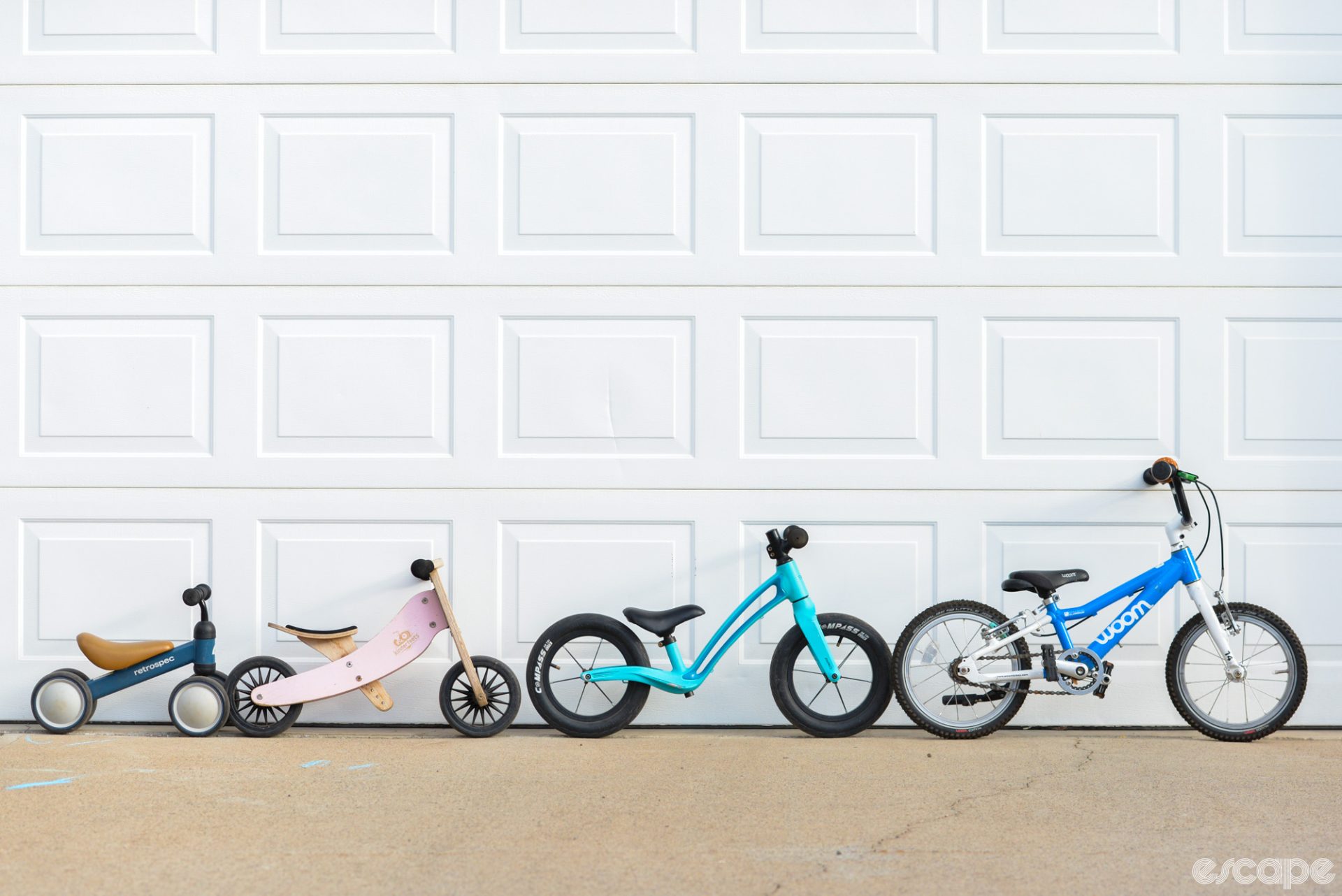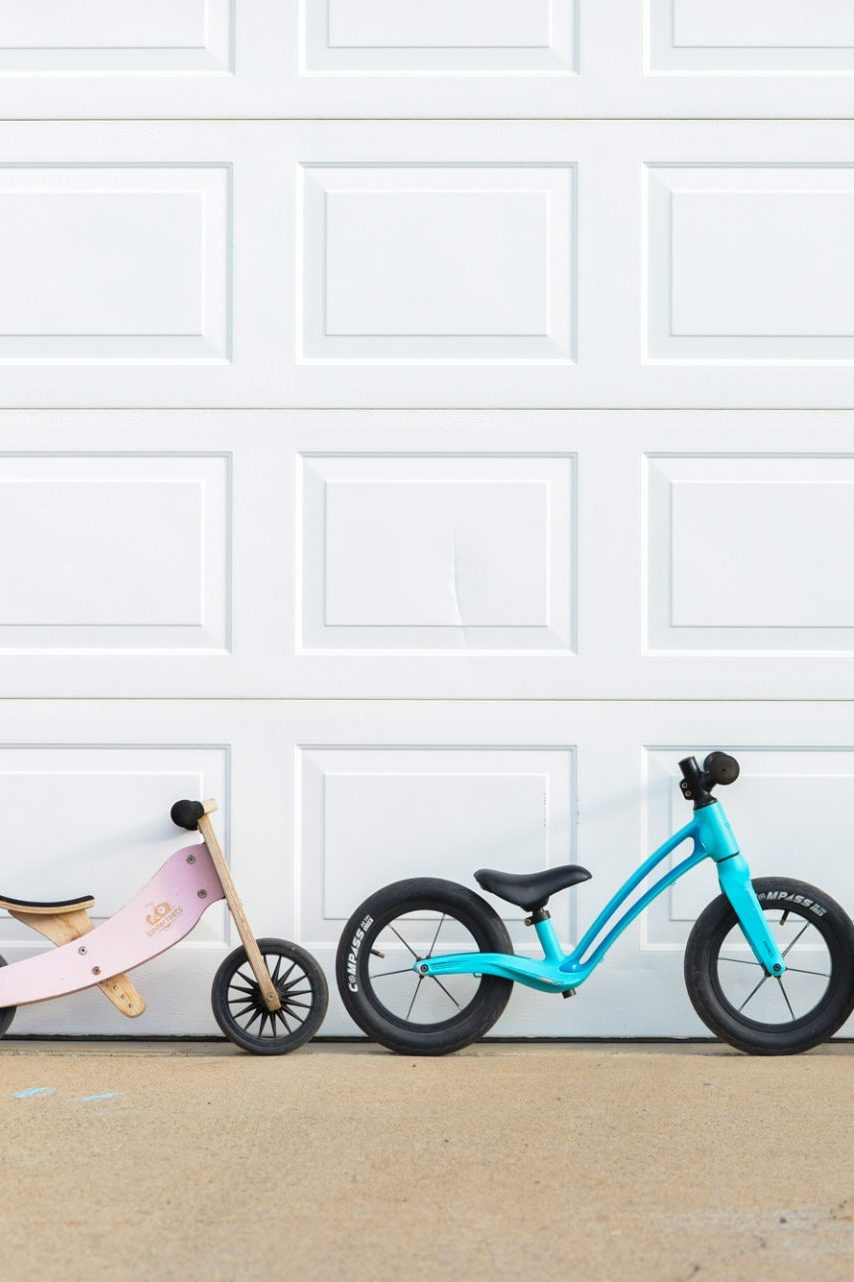We all want our kids to love cruising around on two wheels as much as we do. But all parents know that what we want is rarely all that relevant. Teaching a kid to love bikes is about patience, first and foremost. You need a willingness to wait for the right moment. All we can do is make the right tools accessible at the right times. That’s where this list comes in.
There are hundreds of kids’ bikes out there, and a dozen or more brands make truly excellent ones. The original Strider is still going strong, plus brands like Woom and Cleary and, when they get a bit older, superb high-end rides from the likes of Prevelo. Real mountain bikes for real mountain bike kids – the stuff we only could have dreamed of at their age.
All these options can be daunting, and this isn’t supposed to be a definitive list. This is the story of one kid’s progression, from bike to bike and skill to skill. I hope any new parents out there find it useful, and encourage all the old hands to drop into the comments with any tips, tricks, or bike suggestions that worked for you.
The first bike: Retrospec Cricket
Price: USD $50 / $78 AUD / £40
The Cricket was recommended as a first bike because it stands up on its own (it has four wheels, not two) and has an incredibly low saddle. Kid One was straddling it right around the time she could walk, a bit before her first birthday, and starting moving on it about a month later.
It took another few weeks before she figured out steering. For a while, she would just push, run into something, and then pick the whole bike up (it’s very light) and point it in a new direction.
The downside of the Cricket is that they aren’t actually learning balance and they outgrow it quickly once they figure out pushing and steering. Because it has two front wheels, the head tube angle is a nice sharp 90 degrees. That means with any speed, and any sort of bump, they endo.
Still, Kid One loved it, and the only way we got her onto the next bike was to make the Cricket disappear into the attic.
More info on Retrospec.com.
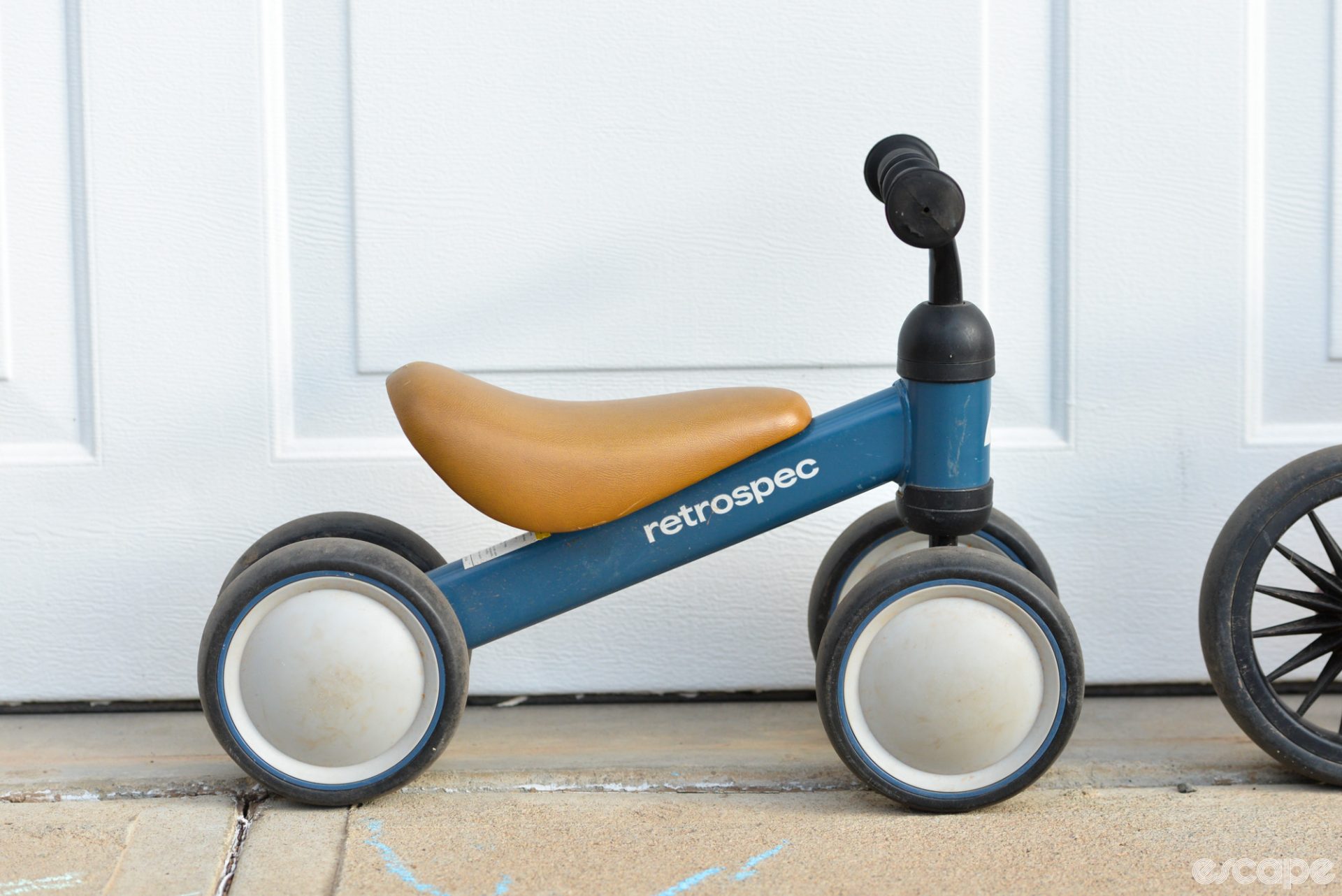

Second bike: Kinderfeets Tiny Tot 2-in-1
Price: USD $99 / AUD $155 / £89
This bike can also be a trike, but we never tried it that way. This came as a hand-me-down from a neighbor and by the time we got it, it was already in two-wheel configuration. That was good for us though, because we were graduating from the more stable Cricket and it was time for two wheels.
This occurred around 18 months for Kid One. Your mileage will vary considerably.
The Kinderfeets is great because the fork/handlebars attach to the frame using a sort of rubber wishbone, which makes it difficult for the kid to jackknife and crash. The seat can go very low, too, down to as low as 8.5 inches (21.5 cm), which is much lower than most balance bikes. I think it’s currently the lowest balance bike on the market, which makes it perfect for bike-crazed parents like us trying to accelerate the learning process as much as is reasonable.
The solid-rubber tires have no air in them, but the front end does at least have a bit of rake to it, so your kid won’t endo instantly when hitting a pebble. It’s a serious upgrade from the Cricket in terms of maneuverability and speed.
Kid One found the Kinderfeets tricky at first because she was used to her bike standing up on its own. She could move around on it but whenever she stopped, or let go, it would fall over and hit her in the leg. This was frustrating and we had to go back to the Cricket for a bit. After another week or two, she grew tired of the Cricket’s slow speed and endless endos and asked for the Kinderfeets (“Pink Bike”) back.
The Kinderfeets is mostly wood, which is both good and bad. It’s light, which is great. But these bikes get beat, left outside in the rain, forgotten at parks, the works. The bike below is on its third kid and going strong but I’m not sure it’ll make it through a fourth, cracks are starting to appear.
More info at Kinderfeets.com
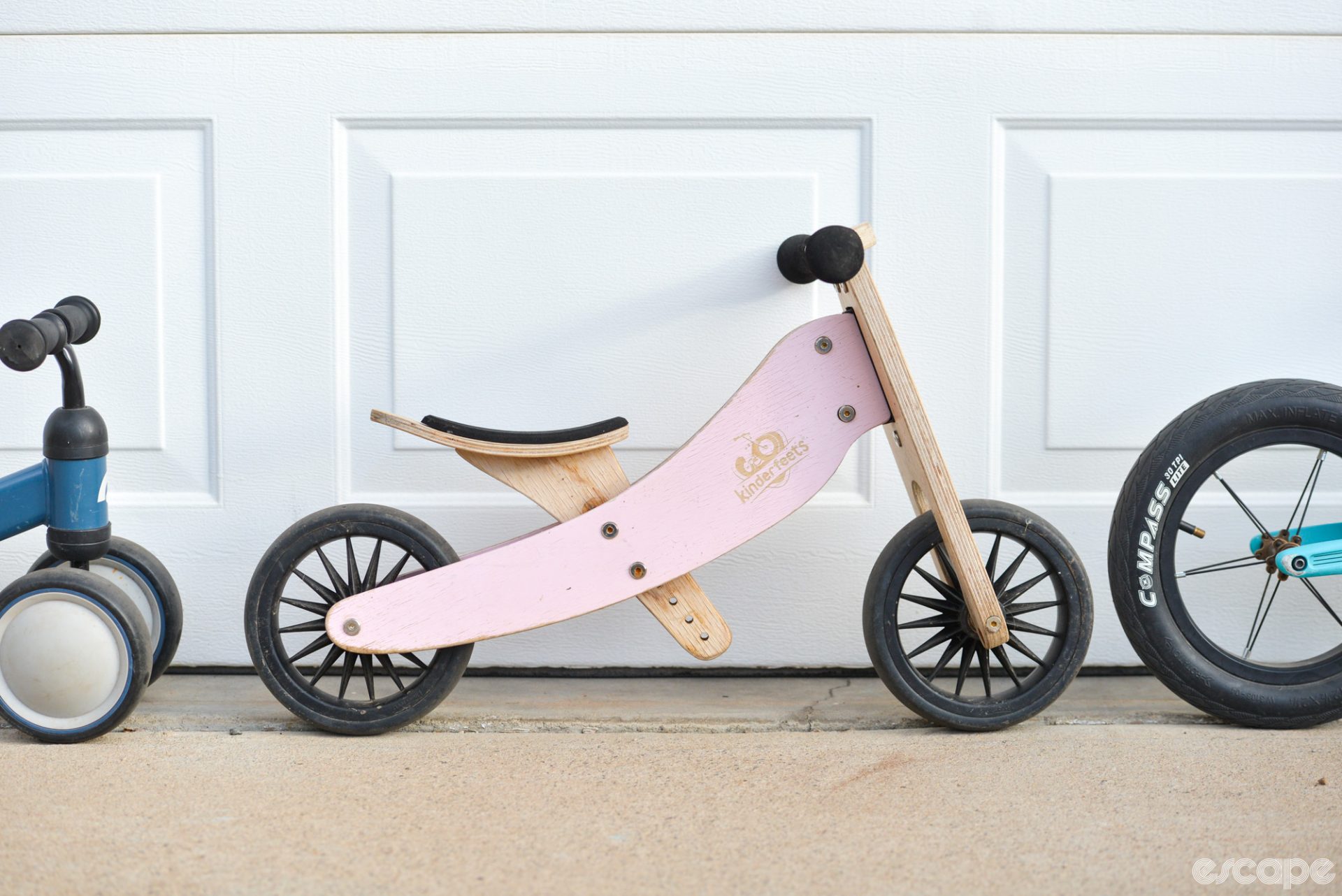

Third bike: Hornit Airo
Price: USD $185 / AUD $269 / £129
Back at an old website that once had some cycling tips, Ronan Mc Laughlin did a group test of strider bikes. The two winners were the ludicrous USD $1,000 Specialized Hotwalk carbon fiber silliness and this, the Hornit Airo. The common denominator: Both are incredibly light.
My daughter was roughly 23 lbs (10 kg) when she got on the Airo. The difference between a 6.5 lb (2.95 kg) bike and a 10 lb (4.5 kg) bike is absolutely massive for somebody that small. It’s no surprise that both my daughter and Ronan’s gravitated towards these light bikes.

The Airo has minimum seat height of about 11 inches, a bit higher than the Kinderfeets. It has real tires, which I leave pumped up to about 10 psi, and the frame is magnesium alloy. It has real hubs and an aluminum handlebar. The 12.5-inch wheels look like mini versions of the old Rolf Vector Pros I raced in 2001. It looks really cool.
Beyond the low weight, the Hornit has a couple other small but smart design choices. Many strider-type bikes use big nuts to attach the wheels, usually covered by crappy plastic that inevitably falls off, exposing ankle-biting metal. Everything on the Hornit sits flush (except the steerer, which I ended up covering in one of those old BMX bike pads) so it doesn’t catch their ankles when they push or add to your misery when your kid falls over.
The one thing it’s missing is a hand brake. As Kid One has gotten bigger and faster, the need for a hand brake has become apparent. We live on a small hill and she can get absolutely cooking going down it, but her only method of stopping is sticking her heels in and doing an unnerving sort of pop-jump thing, or dragging the toes of her shoes. Not great. The Woom 1 is similarly lightweight and has a rear handbrake, as do some of the options from Cleary.
The stock seatpost is also way too long. By the time your kid is tall enough to need all that seatpost, they will probably want pedals. If you stick the stock post all the way down, it sticks out the bottom far enough to catch curbs or ramps (you’ll need to make some shallow ramps, by the way) and cause crashes. So I cut about 3 inches off of it.
The lack of a brake has inspired us to start working on the next bike, a pedal bike.
More info at Hornit.com
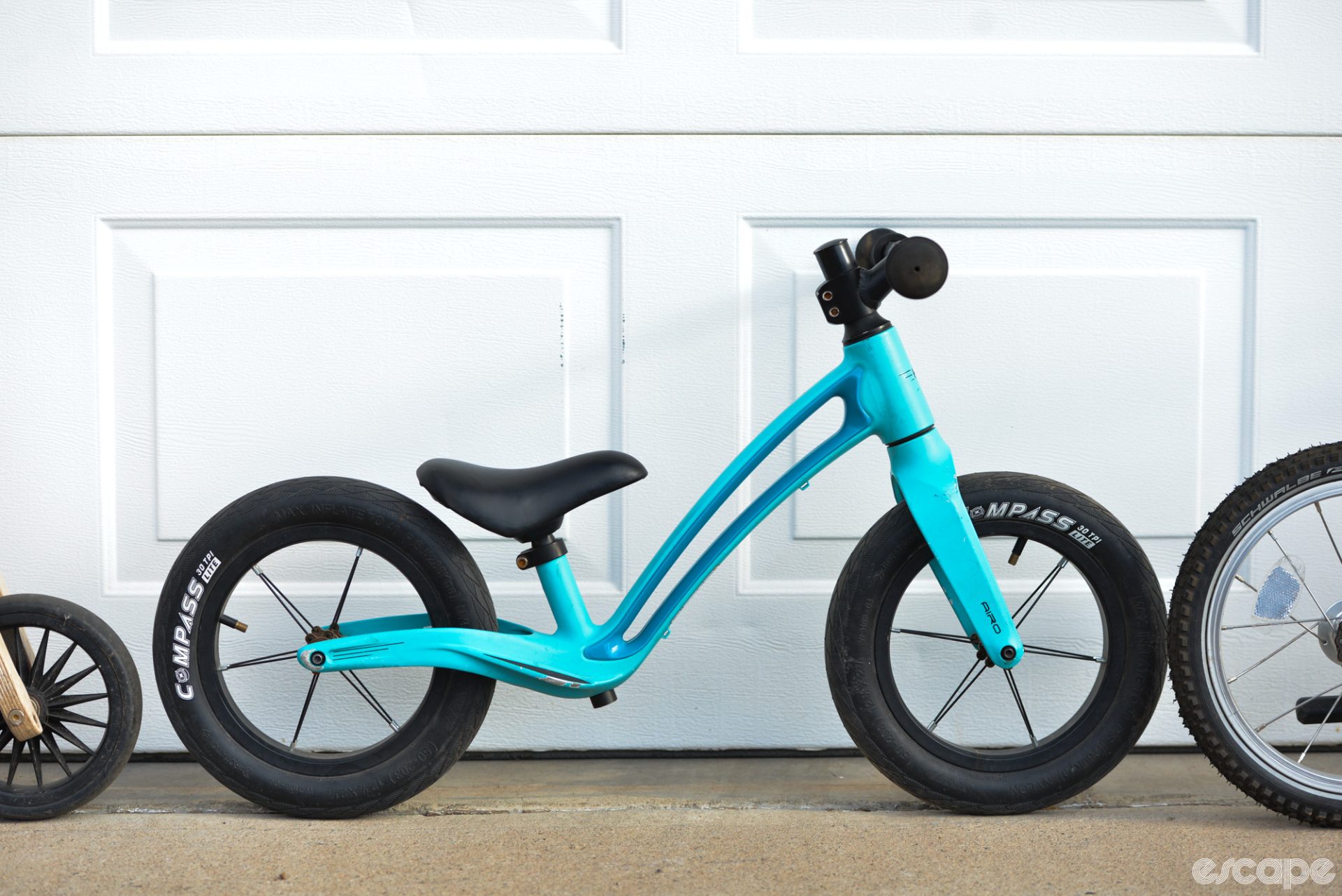

Fourth bike: Woom 2
Price: USD $399 / £325
Woom’s whole range of kid’s bikes comes highly recommended, but the 2 is the first we’ve used. It has front and rear hand brakes, real tires, little tiny cranks, and is good for kids from about three years old onward, according to Woom.
Kid One is just over 2.5 years but is tall enough to get on the Woom 2. She is still pretty hesitant about the actual pedaling. She’ll get on, can balance and glide on it, but is pretty confused by spinning her feet around.
The Woom 2 has everything I want for the next phase though. The brakes are key – in particular, hand brakes instead of a coaster brake. Woom uses little tiny brake levers that work better for little tiny hands.
I like that the tires, Woom-branded Schwalbes, have some real tread to them. We do a fair amount of riding off pavement (our alley is gravel) and kids aren’t the smoothest at steering. Decent traction is necessary to keep their jerky corrections from causing a crash.
It has a steering limiter that doesn’t prevent crashes, but at least prevents the bars spinning into soft little bodies when crashes do happen. It’s also bombproof. We’re family number three to use this bike, and while I had to do a bit of work to cables and housing to make the brakes easy to pull, everything else is still solid.
More info at Woom.com


Tips and tricks:
My experience thus ends at the start of pedal bikes. But other Escape Collective parents are further ahead and have more tips and tricks:
- They will move at their own speed. It doesn’t matter how fast you want them to figure things out, pacing is entirely up to them.
- Look for used. The total cost of the bikes in this story is a somewhat silly USD $733, but I only purchased one of them, the $50 Retrospec. The rest came from neighbors or Ronan (definitely get yourself a Ronan if you can), and there’s a thriving market in used kids’ bikes in many neighborhood groups. Still want to buy from a brand? Woom has a pre-owned program with modest discounts, and a community purchase program for groups of parents to purchase at a discount.
- Nothing is forever. Kids will spend four months refusing to get on a new bike, or refusing to try a new skill, then one day decide it’s time and pick it up in five minutes.
- Using hand brakes as soon as hands are strong enough to do so is helpful later on.
- Start with a flat grassy field and progress to a slightly downhill grassy section to help them get a bit of momentum and to practice gliding.
- Encourage them to look ahead, not at what’s directly in front of them or underneath them.
- When helping, hold the back of the seat or their shoulders, not the handlebars. You want them to learn how to steer, which will come naturally as they figure it out. Let them feel the bike wobbling and learn to correct it themselves.
- Teach them to use their feet to stop by gently placing them on the ground. Make sure they understand the importance of slow, controlled stops to avoid falls. Tell them to use their heels to slow down (Flintstones style!) and not by dragging their toes (unless you want to buy new shoes in a hurry).
- Modeling is helpful. If you have any friends with kids of a similar age who are riding they are often far better teachers than their eager parents.
- Brakes were super helpful when my kid was learning, even when she was still on a push bike. Once they’re past walking speed and able to balance more, it doesn’t take long before they also discover that it’s fun to go downhill, and while they can still stop with their feet, an actual brake can provide a lot more confidence that they’ll be able to stop when they want to. It also makes for an easier transition to a pedal bike (assuming you’re able to get one without a coaster brake, which isn’t the easiest thing to do in the United States).
- You want to be a weight weenie? Have at it, at least when it comes to kid bikes. Don’t think of the weight of their gear in terms of kilograms or pounds; think of it as a percentage of their body weight. Kids – toddlers, particularly – are tiny and have poorly developed muscles, and anything you can do to make their bike easier for them to handle will make it more likely they’ll have a good experience.
- Higher-quality kid bikes may seem outrageously expensive given how quickly they’ll outgrow them, but keep in mind how important it is for things to go well as they’re learning. A good bike really can make a huge difference, and the nicer bikes often have such good resale value that they actually end up costing you less when all is said and done.
- Pneumatic tires and real bearings are surprisingly nice to have, even when your little ones are particularly little. Everything rolls better and you can really air down for a smoother and more comfortable time. Even on balance bikes, a real ball-bearing headset makes it easier to learn how to balance. Ever notice how hard it is to ride no-handed on a bike with a pitted headset? Now imagine you’re three years old and don’t really know to ride at all. It makes a difference.
What did you think of this story?
